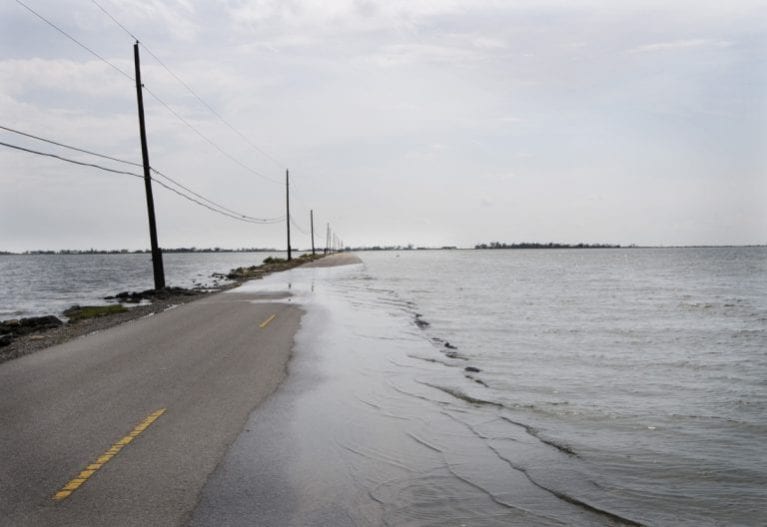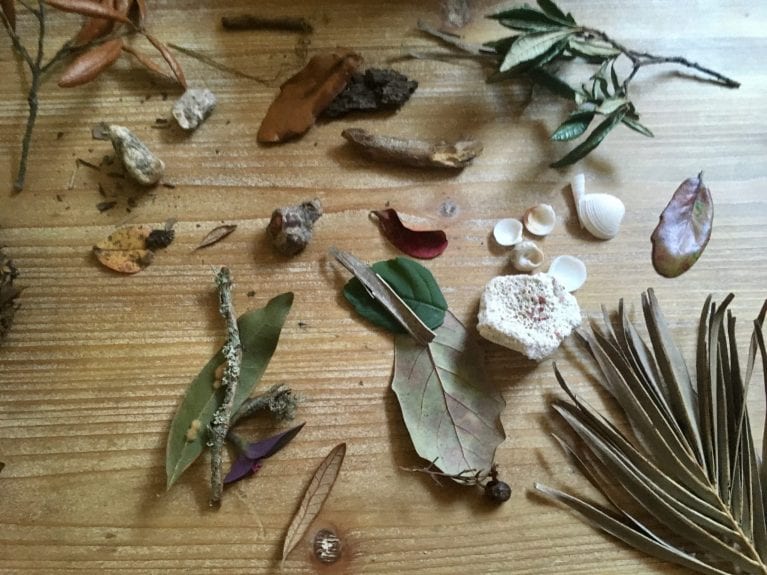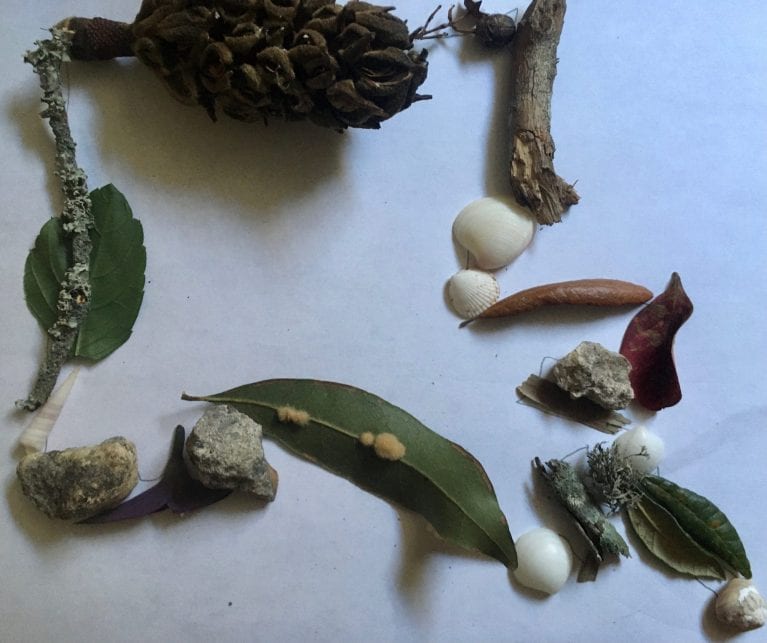New Orleans is referred to as Bulbancha by the Choctaw meaning “the place of many languages” or “the place of many tongues”. The city occupies the territory and traditional homelands of the Chahta Yakni (Choctaw) and Chitimacha.*
Español abajo
Recreate the Louisiana coastline with elements of nature!

Kael Alford, Flooding on Island Road looking toward Isle de Jean Charles 2008, Archival Pigment Print, Gift of Edwin Robinson, 2018.11.16
For seven years, the artist Kael Alford photographed two small communities impacted by coastal erosion, global warming, and the BP oil spill in Louisiana, the Pointe-aux-Chenes and Isle de Jean Charles. Alford’s ancestry can be traced to the native tribes of the region through her maternal grandmother. Her work compassionately tells the story of the people and environments of South Louisiana – the front line of America’s struggle with coastal land loss and climate change.
These communities are home to more than 1,500 people, who are descendants of Native American tribes and French settlers. As this region is becoming increasingly uninhabitable, due to coastal erosion and climate change, the Pointe-aux-Chenes and Isle de Jean Charles communities are the nation’s first climate refugees.
Supplies
Found objects
Instructions
Step 1: With the permission of a parent or guardian, head outside and start gathering! If you’re not able to go for a walk in your neighborhood or backyard, explore your house. What is the environment like on the coast? Find things in nature to use to build the coastline. For example, you can gather rocks, leaves, flowers, little branches…
Let’s take care of our environment and the plants and animals that we share it with. When collecting materials for your artwork, be sure to be mindful of the plants that you might be collecting leaves, branches, or flowers from. Take only what you need and be careful not to damage the plant.
Step 2: With the help of the internet and books, try to name all of your found objects. For example, what is the name of the tree that the leaf or flower that you collected comes from? Try to identify at least one thing that is native to Louisiana.
Step 3: Place your found objects in front of you. Arrange your objects to follow the Louisiana coastline. Try to create a pattern with the objects as you line the coast.
Step 4: When you are done with your assemblage take a picture to share with your friends and family. Be sure to put your found objects back where you found them.
Vocabulary
Pattern: A pattern is a design in which lines, shapes, forms, or colors are repeated.
Native: a person, plant, or animal of indigenous origin or growth
Found Object: a thing that someone else has given or thrown away that is often repurposed by artists
Assemblage: a work of art made by grouping found or unrelated objects together
Coastal Erosion: is the loss or displacement of land, or the long-term removal of sediment and rocks along the coastline due to the action of waves, currents, tides, wind-driven water, waterborne ice, or other impacts of storms.


SEE MORE FUN AT-HOME ACTIVITIES FOR KIDS ON OGDEN MUSEUM ONLINE!
QUESTIONS? EMAIL EDUCATION@OGDENMUSEUM.ORG
*Darensbourg (Atakapa-Ishak), Jeffery. Bulbancha is Still a Place, no. 1 The Tricentennial Issue, POC Zine Project, 2018.
https://www.native-land.ca/ Temprano, Victor. “NativeLand.ca.” Native Land / Our Home on Native Land, Native Land Digital, 2015, native-land.ca/.
____________________________________________________________________
Lunes de movimiento: Ensamblaje de la costa de Luisiana por el Día de los Pueblos Indígenas
¡Recrea la costa de Luisiana con elementos de la naturaleza!

Kael Alford, Flooding on Island Road looking toward Isle de Jean Charles 2008, Archival Pigment Print, Gift of Edwin Robinson, 2018.11.16 | Kael Alford, Inundación en Island Road, Mirando hacia la Isle de Jean Charles, 2008, impresión de archivo por pigmento, obsequio de Edwin Robinson, 2018.11.16
Durante siete años, la artista Kael Alford fotografió a dos pequeñas comunidades afectadas por la erosión costera, el calentamiento global y el derrame de petróleo de BP en Luisiana, Pointe-aux-Chenes y en la Isle de Jean Charles. La ascendencia de Alford se remonta a las tribus nativas de la región a través de su abuela materna. Con delicadeza, su obra cuenta la historia de la gente y el medio ambiente del sur de Luisiana: estado que está en la primera línea de batalla contra la erosión costera y el cambio climático.
Estas comunidades albergan a más de 1.500 personas, que son descendientes de tribus nativas americanas y colonos franceses. Como esta región se está volviendo cada vez más inhabitable, debido a la erosión costera y el cambio climático, las comunidades de Pointe-aux-Chenes y la Isle de Jean Charles son los primeros refugiados climáticos de la nación.
Materiales
Objetos encontrados
Instrucciones
Paso 1: Pídele permiso a un padre o tutor para salir y comenzar a reunirte. Si no puedes dar un paseo por tu barrio o patio trasero, explora tu casa. ¿Cómo es el medio ambiente en la costa? Busca cosas en la naturaleza que puedas usar para construir la costa. Por ejemplo: puedes recoger piedras, hojas, flores o ramitas.
Cuidemos nuestro medio ambiente y las plantas y animales con los que lo compartimos. Al recolectar materiales para tu obra de arte, procura cuidar las plantas de las que podrías recolectar hojas, ramas o flores. Toma sólo lo que necesites y ten cuidado de no dañar la planta.
Paso 2: Con la ayuda de Internet y de libros, intenta nombrar todos tus objetos encontrados. Por ejemplo: ¿cuál es el nombre del árbol del que proviene la hoja o flor que recolectaste? Intenta identificar al menos una cosa que sea autóctona de Luisiana.
Paso 3: Coloca los objetos encontrados frente a ti. Organiza tus objetos de forma que bordeen la costa de Luisiana. Intenta crear un patrón con los objetos a medida que recorres la costa.
Paso 4: Cuando hayas terminado con tu ensamblaje, toma una foto para compartir con tus amigos y familiares. Asegúrate de volver a poner los objetos encontrados en su lugar.

Vocabulario
Patrón: Un patrón es un diseño en el que se repiten líneas, formas o colores.
Autóctono: una persona, planta o animal de origen o crecimiento indígena
Objeto encontrado: un objeto que alguien donó o descartó y que los artistas reutilizan para hacer arte.
Ensamblaje: una obra de arte hecha agrupando objetos encontrados o no relacionados
Erosión costera: es la pérdida o desplazamiento de tierra, o la remoción a largo plazo de sedimentos y rocas a lo largo de la costa debido a la acción de olas, corrientes, mareas, agua impulsada por el viento, hielo transmitido por el agua u otros impactos de tormentas.


¡VE MÁS ACTIVIDADES DIVERTIDAS PARA NIÑOS PARA HACER EN CASA EN OGDEN MUSEUM ONLINE!
¿PREGUNTAS? ENVÍA UN EMAIL A EDUCATION@OGDENMUSEUM.ORG.
Translation by Agostina Coll
